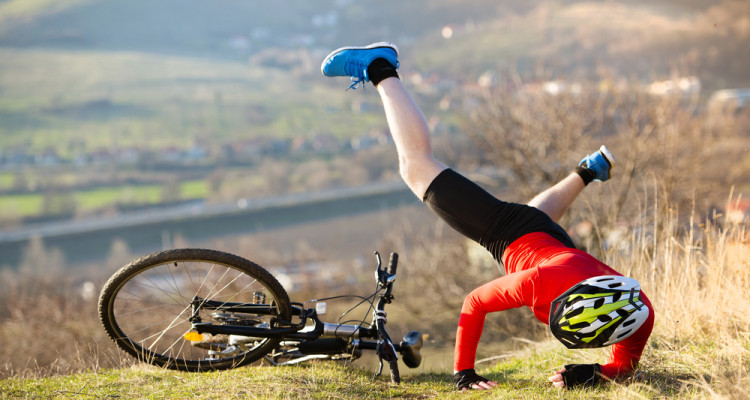Get in your car, accelerate to 30 miles per hour, strip down to your underwear, open the door, and jump out, That’s how crashing a road bike has been described to me, and I can tell you from experience that this metaphor glorifies the process.
A few weeks back, on a large, fast group ride, the cyclist directly in front of me got into the wheel of the rider in front of him. When your front wheel comes out from underneath you at 25 mph, you hit the asphalt very quickly. Unfortunately for me, there was no place for me to go other than head first over the handlebars. I remember hearing the sound of my helmet scraping across the ground and I realized the left side of my face was doing the same.
Related: Will Cycling in Southwest Florida Ever Be Safe?
As I lay in the middle of Bonita Beach road, I could hear someone say, “Call 911,” as someone else moaned in pain—I knew I wasn’t the only one on the ground. I touched my cheek and looked at my fingertips. The amount of blood let me know that I had definitely scratched up the money maker. I wiggled my fingers and toes and realized that I was capable of standing up. I walked to the side of the road and removed my Lazer Helium helmet and saw the damage to it. After that, my friends forced me to sit very still without moving my neck and kept me stationary until the paramedics arrived.
My jersey had been destroyed in the bike crash. I was laying on the hospital bed in my cycling shorts with no fewer than a dozen open, bloody wounds, the nurse looked me over and asked, “Did this happen today?”
“No, it’s been going on for a few weeks but I finally thought I should come in and get it checked out,” I replied.
My wife threw me the hairy eyeball and told me to be nice. The nurse realized how silly her question was and looked embarrassed. I told her that I landed on my head and my shoulder at 25 mph and showed her the helmet. The nurses passed it around and were shocked I wasn’t dead. From reviewing the carnage of the bike and the remains of my equipment, it is fairly evident that my head was either the first or second piece of me to hit the ground—and yet, remarkably, I had no concussion. I didn’t even have a headache. After a series of CT scans and x-rays, it was determined that nothing was broken other than a bit of skin.
The other cyclist in the ambulance with me suffered from a broken clavicle, several broken ribs, and a punctured lung. I, on the other hand, was going to need a few Band-Aids. While this was partially the result of plain good luck, I also want to recognize the quality of the gear I was fortunate enough to have been wearing. A few years back, I had done a product review of the helmet I had been wearing during the bike crash. At the time, I rated it one of the best I had ever tried, and I’ll stand by that now. The Lazer Helium did exactly what it is supposed to do: it absorbed the energy of the crash and compressed so my skull did not. Road bike helmets are good for one crash only, so once you have damaged the integrity of the structure, you throw it away and get another one. My favorite helmet had died so I could live.
Related: If You Want To Be A Better, Faster Cyclist, You Need The Right Gear
Often times I see recreational riders in ill-fitting, improperly adjusted (and sometimes backwards) helmets. Had my helmet not been adjusted properly, my head would have absorbed that blow. I can only say that the impact of my temple on the ground at the speed I was going was more than enough to kill me.
I walked away from the crash and was back on my bike in a few days because I always follow the tips below:
1. Your helmet should sit level on your head (not pulled down over your eyes, not pushed up over your forehead). I try to keep mine just above my eyebrows so the front of the helmet is just visible to me.
2. The adjustment on the back or top of the helmet will tighten a strap or band inside the helmet and pull it snug onto your head. I like to keep mine so snug that I can bend over and it stays in place without having the chin strap clipped. Keep in mind, you don’t know how much twisting you may do on your way to the ground, so you do not want that helmet to move before you get there.
3. Adjust the chin straps so they are even around your ears. The chin straps should be tightened up so that when you open your mouth you can feel the helmet pulling down onto your head (not a bad idea, as you are probably going to be shouting an expletive as you are falling).
4. Sunglasses should be worn over the helmet straps. In the event of a crash they are likely to fly off. If they are under the straps they are likely to get jammed into your face, which could cause them to harm you or break. When you’re dealing with a crash, do you really need extra shattered glass near your eyeballs?
5. Always wear a helmet! I have a belief that if you ride without wearing a helmet, the Karma Gods owe you a crash. Don’t risk it. I know helmets can be pricey, but your head is worth the investment.
More biking stories you’ll love…
BMX Phenom Michelle Huey Knows Good Gear

